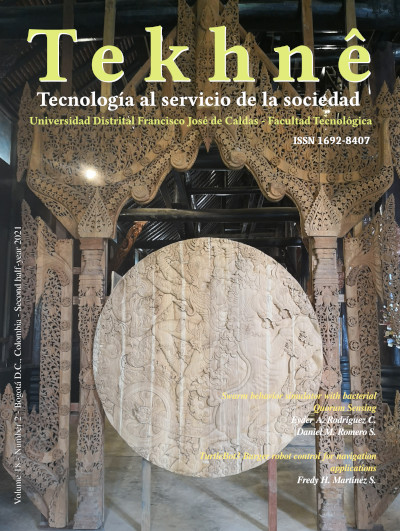Published:
2021-12-24Issue:
Vol. 18 No. 2 (2021): Tekhnê JournalSection:
ArticlesSwarm behavior simulator with bacterial Quorum Sensing
Simulador de comportamiento de enjambre con Quorum Sensing bacteriano
Keywords:
Path-planning, quorum sensing, simulator, software, swarm (en).Keywords:
Enjambre, Planificación de rutas, quorum sensing, simulador, software (es).Downloads
Abstract (en)
One of the most useful tools in the design of path-planning solutions is simulators. Thanks to them, it is possible to predict the performance of certain control strategies. In this paper, a simulator is presented that implements a swarm of automatons, which perform a wild motion in a user-selected environment. The robots will have the quality to avoid collisions with different obstacles that affect their mobility since they are equipped with proximity sensors. The interface of this simulator was designed entirely with the Qt Designer software. Successful configurations that replicate the performance of the real prototype are presented.
Abstract (es)
Una de las herramientas más útiles en el diseño de soluciones de planificación de trayectorias son los simuladores. Gracias a ellos, es posible predecir el rendimiento de determinadas estrategias de control. En este trabajo se presenta un simulador que implementa un enjambre de autómatas que realizan un movimiento salvaje en un entorno seleccionado por el usuario. Los robots tendrán la cualidad de evitar colisiones con diferentes obstáculos que afecten a su movilidad ya que están equipados con sensores de proximidad. La interfaz de este simulador se ha diseñado íntegramente con el software Qt Designer. Se presentan configuraciones exitosas que replican el desempeño del prototipo real.
References
Bobadilla, L., Martinez, F., Gobst, E., Gossman, K., & LaValle, S. M. (2012). Controlling wild mobile robots using virtual gates and discrete transitions. 2012 American Control Conference (ACC). https://doi.org/10.1109/acc.2012.6315569
Cody, J. R., & Adams, J. A. (2017). An evaluation of quorum sensing mechanisms in collective value-sensitive site selection. 2017 International Symposium on Multi-Robot and Multi-Agent Systems (MRS). https://doi.org/10.1109/mrs.2017.8250929
Ferrante, E., Turgut, A. E., Huepe, C., Stranieri, A., Pinciroli, C., & Dorigo, M. (2012). Self-organized flocking with a mobile robot swarm: A novel motion control method. Adaptive Behavior, 20(6), 460–477. https://doi.org/10.1177/1059712312462248
Flikkema, P., & Leid, J. (2005). Bacterial communities: A microbiological model for swarm intelligence. Proceedings 2005 IEEE Swarm Intelligence Symposium, 2005. SIS 2005. https://doi.org/10.1109/sis.2005.1501655
Gómez, P., & Rodríguez, A. (2011). Simulating a rock-scissors-paper bacterial game with a discrete cellular automaton. In New challenges on bioinspired applications (pp. 363–370). Springer Berlin Heidelberg. https://doi.org/10.1007/978-3-642-21326-7_39
Hsieh, M. A., Halász, Á., Berman, S., & Kumar, V. (2008). Biologically inspired redistribution of a swarm of robots among multiple sites. Swarm Intelligence, 2(2-4), 121–141. https://doi.org/10.1007/s11721-008-0019-z
Huang, C. X., Zhang, B., Deng, A.-C., & Swirski, B. (1995). The design and implementation of PowerMill. Proceedings of the 1995 international symposium on Low power design - ISLPED ’95. https://doi.org/10.1145/224081.224100
Ichter, B., Harrison, J., & Pavone, M. (2018). Learning sampling distributions for robot motion planning. 2018 IEEE International Conference on Robotics and Automation (ICRA). https://doi.org/10.1109/icra.2018.8460730
Khan, A., Noreen, I., & Habib, Z. (2017). On complete coverage path planning algorithms for non-holonomic mobile robots: Survey and challenges. Journal of Information Science & Engineering, 33(1), 101–121.
Korani, W. M. (2008). Bacterial foraging oriented by particle swarm optimization strategy for PID tuning. Proceedings of the 2008 GECCO conference companion on Genetic and evolutionary computation - GECCO ’08. https:// doi.org/10.1145/1388969.1388980
Lo, C., Wei, G., & Marculescu, R. (2015). Towards autonomous control of molecular communication in populations of bacteria. Proceedings of the Second Annual International Conference on Nanoscale Computing and Communication. https://doi.org/10.1145/2800795.2800822
Martínez, F., Jacinto, E., & Hernández, C. (2012). Particle diffusion model applied to the swarm robots navigation. Tecnura, 16(2012), 34–43.
Martínez, F., Martínez, F., & Montiel, H. (2020). Bacterial quorum sensing applied to the coordination of autonomous robot swarms. Bulletin of Electrical Engineering and Informatics, 9(1), 67–74. https://doi.org/10.11591/eei.v9i1.1538
Mohanan, M., & Salgoankar, A. (2018). A survey of robotic motion planning in dynamic environments. Robotics and Autonomous Systems, 100(2018), 171–185. https://doi.org/10.1016/j.robot.2017.
011
Patle, B., L, G. B., Pandey, A., Parhi, D., & Jagadeesh, A. (2019). A review: On path planning strategies for navigation of mobile robot. Defence Technology, 15(4), 582–606. https://doi.org/10.1016/j.dt.2019.04.011
Roozbahani, H., & Handroos, H. (2019). A novel haptic interface and universal control strategy for international thermonuclear experimental reactor (ITER) welding/machining assembly robot. Robotics and Computer-Integrated Manufacturing, 57, 255–270. https://doi.org/10.1016/j.rcim.2018.12.011
How to Cite
APA
ACM
ACS
ABNT
Chicago
Harvard
IEEE
MLA
Turabian
Vancouver
Download Citation
Visitas
Downloads
License
Copyright (c) 2021 Eyder A. Rodríguez C., Daniel M. Romero S.

This work is licensed under a Creative Commons Attribution-NonCommercial-NoDerivatives 4.0 International License.
Those authors who have published with this journal agree to the following terms:
- The authors retain their copyright and guarantee to the journal right of first publication of his work, which will be simultaneously subject to license recognition of Creative Commons that allows others to share the work as long as its author is indicated and its first publication in this journal.
- Authors may adopt other agreements nonexclusive distribution version of the work as long as indicated that the initial publication is in this journal.
- It allows and encourages authors disseminate their work via the Internet before and during the submission process, which can produce interesting exchanges and increase citations of the published work.


